- Share
NASA’s Glenn Research Center focuses on “solving the problems of flight” from its campuses in Cleveland and Sandusky, Ohio
And while it is doing it, the center contributes more than $2 billion annually to Ohio’s economy, Glenn officials told Cleveland Fed president and chief executive officer Beth M. Hammack during a recent visit to the storied Cleveland campus.
NASA’s Glenn Research Center has deep roots in Cleveland. Its main campus, now called Lewis Field, was established by the 1941 groundbreaking for the Aircraft Engine Research Laboratory of the National Advisory Committee for Aeronautics (forerunner to NASA). In a recent visit to the campus, Cleveland Fed president and chief executive officer Beth Hammack learned from NASA officials about how the Glenn Research Center team helped make NASA’s most famous missions possible. Additionally, she heard about how the center advances the safety and fuel efficiency of today’s commercial airliners and works tirelessly to innovate new technology and transfer it to industry for the benefit of all.
Center director Dr. Jimmy Kenyon summarized the work of the Glenn Research Center team as “solving the problems of flight” but was quick to mention that it’s not as simple as it sounds. As the only NASA center focused on aircraft propulsion, the researchers and scientists at Glenn are often handed the toughest problems not only in propulsion, but also in power systems, communications, and materials for aeronautics and space exploration.
Dr. Kenyon and members of his team—Mary Wadel, director of technology integration and partnerships; Larry Sivic, associate center director; and Bryan Smith, director of facilities, test and center operations directorate—spent time with Hammack to provide an overview of how the Glenn Research Center is woven into the fabric of Ohio’s economy.
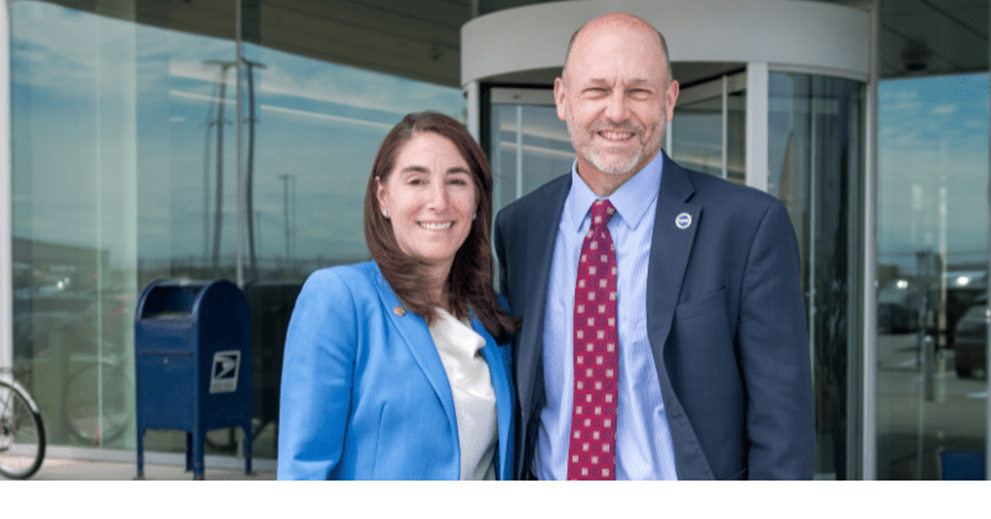
Hammack and Glenn research director Dr. Jimmy Kenyon spent time discussing the center’s regional economic impact and contribution to technology innovation in a recent visit to Lewis Field.
The Glenn Research Center creates and supports over 9,000 jobs.1 It employs approximately 1,500 civil servants, the majority of whom are scientists and engineers, and nearly the same number of contractors. Teams work across more than 191 buildings situated on the Lewis Field main campus in Cleveland and the Armstrong Test Facility site in Sandusky.
Hammack inquired during the tour about the center’s recruitment strategy given the unique skillsets required of its employees. She learned that the Glenn Research Center recruits nationally but finds that individuals with ties to the region are more likely to apply and stay. Dr. Kenyon and Hammack discussed two factors that may support that: first, the proximity of the center to universities with strong engineering programs, and second, the ability of the region to retain its residents and attract back those who have left (the boomerang migration effect). The Cleveland Fed’s regional research team studies population migration trends in the Fourth District and recently published data on boomerang migration, finding that on balance, District metro areas perform well compared to the national average.2
A strong employee base and local supplier spend helps the Glenn Research Center generate nearly $842 million in labor income and approximately $222 million in tax revenue per year for Ohio’s economy.3 That’s in addition to contributing to private sector revenue and job growth by licensing its inventions through its technology transfer programs.
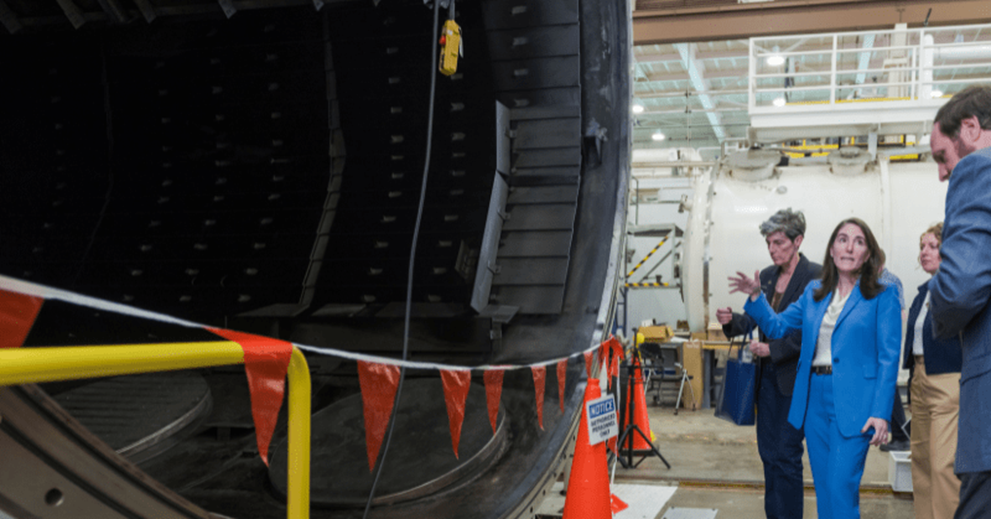
Hammack discusses the work done at the Icing Research Tunnel (IRT) facility at Lewis Field. The IRT is the longest running icing facility in the world and has been in operation since 1944.
Additionally, Hammack learned how the Glenn Research Center makes its facilities available to startups and businesses in need of specialized test or laboratory equipment. At the time of her visit, the Glenn Research Center had 39 active agreements with organizations in Ohio, and the center routinely manages 100+ agreements at any given time. Many of these organizations are small businesses, which play an important role in the US economy. Small businesses employ nearly half of private-sector workers and are catalysts for innovation and growth on Main Street, according to the research staff of the Federal Reserve Small Business Credit Survey.

A Glenn Research Center scientist shares the work on fission surface power that members of the team are doing to support the Artemis program. This program, NASA’s effort to return humans to the Moon and establish a long-term presence there, will require new power technologies to support life on the lunar surface.
The Glenn Research Center also participates in the Small Business Innovation Research (SBIR) and Small Business Technology Transfer (STTR) programs, part of the America’s Seed Fund powered by the Small Business Administration. According to Wadel, Glenn-supported applicants received approximately $384 million in SBIR and STTR funding, making Ohio the ninth-ranked state across total NASA-supported recipients over the 2014–2024 period.
After the discussion, Hammack toured several sites on the 350-acre Lewis Field campus, meeting employees and learning about the work being done to support fission surface power generation (a necessity for sustaining power on the lunar surface, where the sun doesn’t shine for two weeks at a time) and a new communications technology testing facility supporting the Artemis mission.
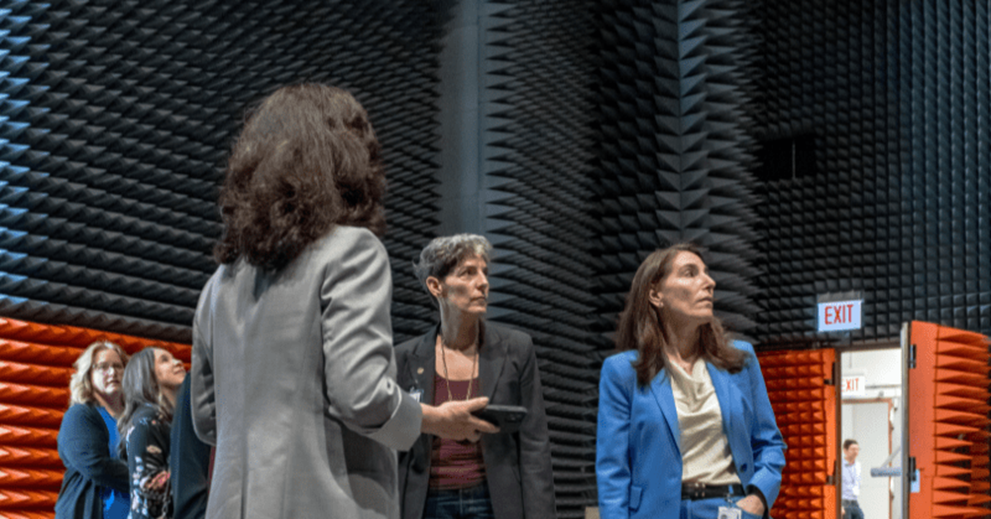
Hammack (right) and Lisa Barrow (second from right), vice president of regional analysis at the Cleveland Fed, learn about one of Glenn Research Center’s newest testing spaces for long-range communications technology. Work in this facility supports the Artemis mission and infrastructure for other innovations like air taxi services. Fun fact: NASA’s Glenn Research Center holds an Emmy for its work on early satellite TV.
During her tour of the Lewis Field campus, Hammack also learned about The Simulated Lunar Operations (SLOPE) laboratory. The lab provides controlled test conditions to evaluate the tractive performance of roving vehicles on simulated lunar and Martian terrain.
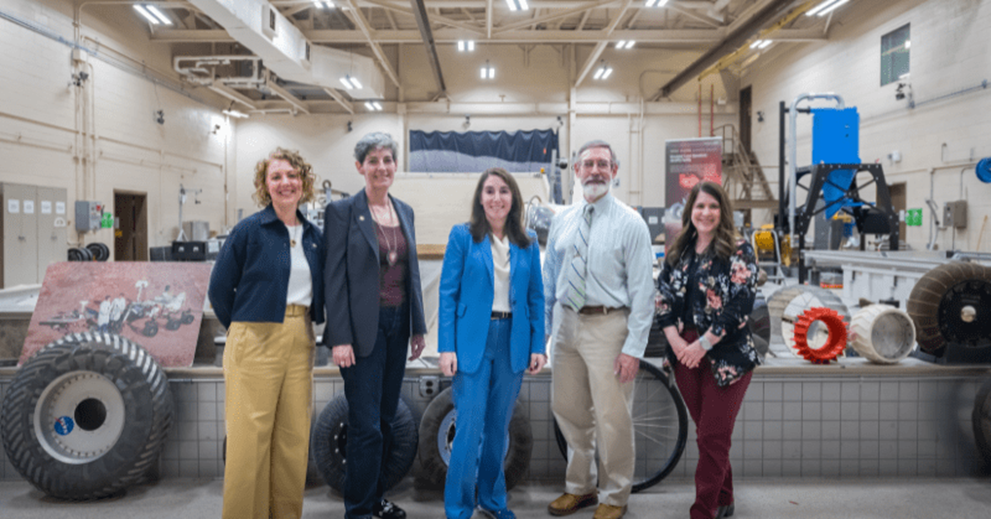
Dr. Phil Abel (second from right) of NASA’s Glenn Research Center and members of the Cleveland Fed visit the center’s Simulated Lunar Operations (SLOP) Laboratory, which is used to evaluate the performance of vehicles on simulated lunar and Martian terrain under controlled test conditions.
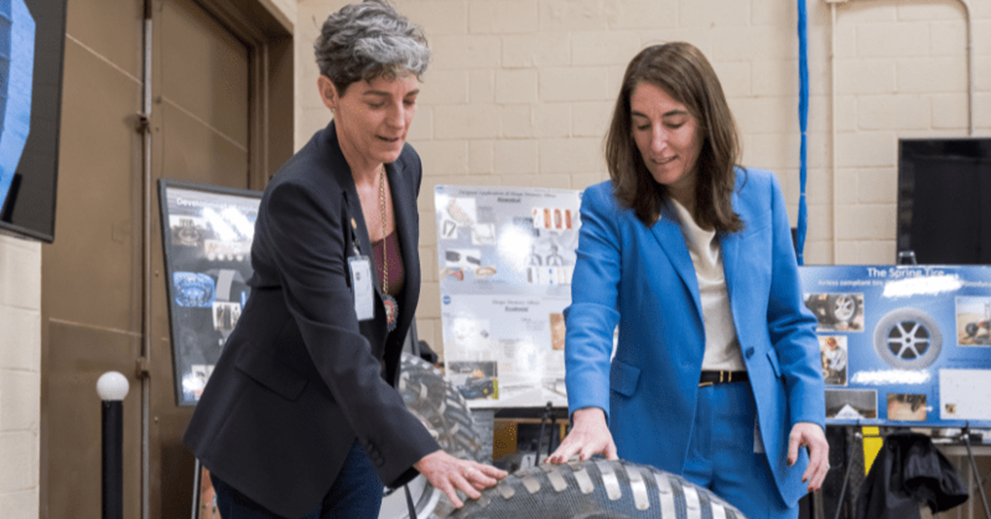
Hammack (right) and Barrow (left) examine one of the roving vehicle tires on display at The Simulated Lunar Operations (SLOPE) Laboratory at NASA’s Glenn Research Center.
About President Beth M. Hammack’s Around the District tour
President Hammack is visiting communities across the Fourth District as part of her Around the District tour to meet and connect with the people who live and work in all corners of the region and to gain a better understanding of how the economy is working in different communities. The Cleveland Fed, with branches in Cincinnati and Pittsburgh, serves an area that comprises Ohio, western Pennsylvania, eastern Kentucky, and the northern panhandle of West Virginia. Hammack will use this information to inform her policy views and better represent the Fourth District around the Federal Open Market Committee table.
Footnotes
- 10 Things to Know About NASA’s Glenn Research Center, About NASA's Glenn Research Center - NASA Return to 1
- Whitaker, Stephan D., and Brett Huettner. 2025. “Boomerang Migration: Which Regions Have the Most, and Can It Make a Difference?” Federal Reserve Bank of Cleveland, Cleveland Fed District Data Brief. https://doi.org/10.26509/frbc-ddb-20250219 Return to 2
- The NASA Glenn Research Center: An Economic Impact Study Fiscal Year 2023, prepared by Molly S. Schnoke, Georgina Figueroa, and Jack Yochum of the Levin College of Public Affairs and Education at Cleveland State University: The NASA John H. Glenn Research Center: An Economic Impact Study Fiscal Year 2023 Return to 3
Office of the President
Learn about the work of the president and CEO of the Federal Reserve Bank of Cleveland.
Beth M. Hammack
Beth M. Hammack is the president and chief executive officer of the Federal Reserve Bank of Cleveland, one of 12 regional Reserve Banks in the Federal Reserve System.
About Us
The Federal Reserve Bank of Cleveland (commonly known as the Cleveland Fed) is part of the Federal Reserve System, the central bank of the United States.

